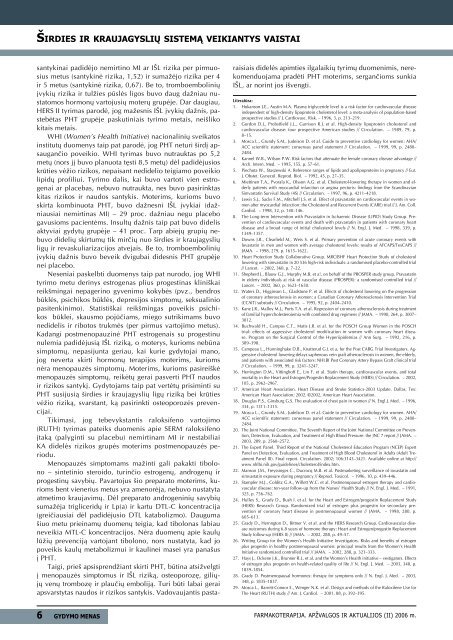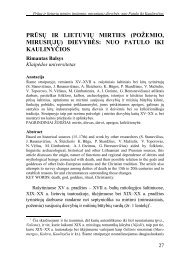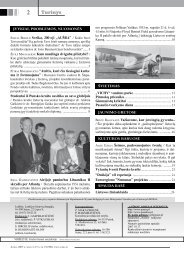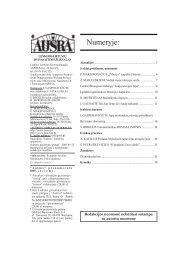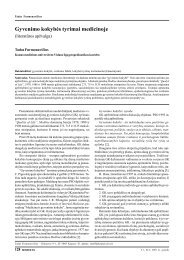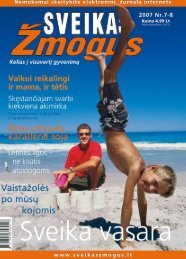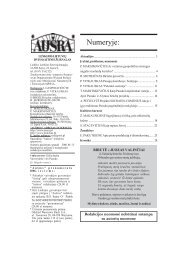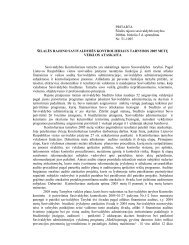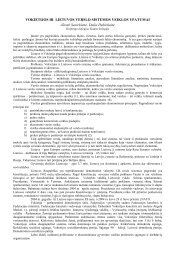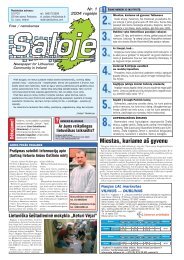VAISTAI ALERGINÄ–MS LIGOMS GYDYTI - e-library.lt
VAISTAI ALERGINÄ–MS LIGOMS GYDYTI - e-library.lt
VAISTAI ALERGINÄ–MS LIGOMS GYDYTI - e-library.lt
You also want an ePaper? Increase the reach of your titles
YUMPU automatically turns print PDFs into web optimized ePapers that Google loves.
Širdies ir kraujagyslių sistemą veikiantys vaistai<br />
santykinai padidėjo nemirtino MI ar IŠL rizika per pirmuosius<br />
metus (santykinė rizika, 1,52) ir sumažėjo rizika per 4<br />
ir 5 metus (santykinė rizika, 0,67). Be to, tromboembolinių<br />
įvykių rizika ir tulžies pūslės ligos buvo daug dažniau nustatomos<br />
hormonų vartojusių moterų grupėje. Dar daugiau,<br />
HERS II tyrimas parodė, jog mažesnis IŠL įvykių dažnis, pastebėtas<br />
PHT grupėje paskutiniais tyrimo metais, neišliko<br />
kitais metais.<br />
WHI (Women’s Hea<strong>lt</strong>h Initiative) nacionalinių sveikatos<br />
institutų duomenys taip pat parodė, jog PHT neturi širdį apsaugančio<br />
poveikio. WHI tyrimas buvo nutrauktas po 5,2<br />
metų (nors jį buvo planuota tęsti 8,5 metų) dėl padidėjusios<br />
krūties vėžio rizikos, nepaisant nedidelio teigiamo poveikio<br />
lipidų profiliui. Tyrimo dalis, kai buvo vartoti vien estrogenai<br />
ar placebas, nebuvo nutraukta, nes buvo pasirinktas<br />
kitas rizikos ir naudos santykis. Moterims, kurioms buvo<br />
skirta kombinuota PHT, buvo dažnesni IŠL įvykiai (dažniausiai<br />
nemirtinas MI) – 29 proc. dažniau negu placebo<br />
gavusioms pacientėms. Insu<strong>lt</strong>ų dažnis taip pat buvo didelis<br />
aktyviai gydytų grupėje – 41 proc. Tarp abiejų grupių nebuvo<br />
didelių skirtumų tik mirčių nuo širdies ir kraujagyslių<br />
ligų ir revaskuliarizacijos atvejais. Be to, tromboembolinių<br />
įvykių dažnis buvo beveik dvigubai didesnis PHT grupėje<br />
nei placebo.<br />
Neseniai paskelbti duomenys taip pat nurodo, jog WHI<br />
tyrimo metu derinys estrogenas plius progestinas kliniškai<br />
reikšmingai nepagerino gyvenimo kokybės (pvz., bendros<br />
būklės, psichikos būklės, depresijos simptomų, seksualinio<br />
pasitenkinimo). Statistiškai reikšmingas poveikis psichikos<br />
būklei, skausmo pojūčiams, miego sutrikimams buvo<br />
nedidelis ir ribotos trukmės (per pirmus vartojimo metus).<br />
Kadangi postmenopauzinė PHT estrogenais su progestinu<br />
nulemia padidėjusią IŠL riziką, o moterys, kurioms nebūna<br />
simptomų, nepasijunta geriau, kai kurie gydytojai mano,<br />
jog neverta skirti hormonų terapijos moterims, kurioms<br />
nėra menopauzės simptomų. Moterims, kurioms pasireiškė<br />
menopauzės simptomų, reikėtų gerai pasverti PHT naudos<br />
ir rizikos santykį. Gydytojams taip pat vertėtų prisiminti su<br />
PHT susijusią širdies ir kraujagyslių ligų riziką bei krūties<br />
vėžio riziką, svarstant, ką pasirinkti osteoporozės prevencijai.<br />
Tikimasi, jog tebevykstantis raloksifeno vartojimo<br />
(RUTH) tyrimas pateiks duomenis apie SERM raloksifeno<br />
įtaką (palyginti su placebu) nemirtinam MI ir nestabiliai<br />
KA didelės rizikos grupės moterims postmenopauzės periodu.<br />
Menopauzės simptomams mažinti gali pakakti tibolono<br />
– sintetinio steroido, turinčio estrogenų, androgenų ir<br />
progestinų savybių. Pavartojus šio preparato moterims, kurioms<br />
bent vienerius metus yra amenorėja, nebuvo nustatyta<br />
atmetimo kraujavimų. Dėl preparato androgeninių savybių<br />
sumažėja trigliceridų ir Lp(a) ir kartu DTL-C koncentracija<br />
(greičiausiai dėl padidėjusio DTL katabolizmo). Dauguma<br />
šiuo metu prieinamų duomenų teigia, kad tibolonas labiau<br />
neveikia MTL-C koncentracijos. Nėra duomenų apie kaulų<br />
lūžių prevenciją vartojant tibolono, nors nustatyta, kad jo<br />
poveikis kaulų metabolizmui ir kaulinei masei yra panašus<br />
į PHT.<br />
Taigi, prieš apsisprendžiant skirti PHT, būtina atsižvelgti<br />
į menopauzės simptomus ir IŠL riziką, osteoporozę, giliųjų<br />
venų trombozę ir plaučių emboliją. Turi būti labai gerai<br />
apsvarstytas naudos ir rizikos santykis. Vadovaujantis pasta-<br />
gydymo menas<br />
raisiais didelės apimties ilgalaikių tyrimų duomenimis, nerekomenduojama<br />
pradėti PHT moterims, sergančioms sunkia<br />
IŠL, ar norint jos išvengti.<br />
Literatūra:<br />
1. Hokanson J.E., Austin M.A. Plasma triglyceride level is a risk factor for cardiovascular disease<br />
independent of high-density lipoprotein cholesterol level: a meta-analysis of population-based<br />
prospective studies // J. Cardiovasc. Risk. – 1996, 3, p. 213–219.<br />
2. Gordon D.J., Probstfield J.L., Garrison R.J. et al. High-density lipoprotein cholesterol and<br />
cardiovascular disease: four prospective American studies // Circulation. – 1989, 79, p.<br />
8–15.<br />
3. Mosca L., Grundy S.M., Judeison D. et al. Guide to preventive cardiology for women: AHA/<br />
ACC scientific statement: consensus panel statement // Circulation. – 1999, 99, p. 2480–<br />
2484.<br />
4. Kannel W.B., Wilson P.W. Risk factors that attenuate the female coronary disease advantage //<br />
Arch. Intern. Med. – 1995, 155, p. 57–61.<br />
5. Piechota W., Staszewski A. Reference ranges of lipids and apolipoproteins in pregnancy // Eur.<br />
J. Obstet. Gynecol. Reprod. Biol. – 1992, 45, p. 27–35.<br />
6. Miettinen T.A., Pvorala K., Olsson A.G. et al. Cholesterol-lowering therapy in women and elderly<br />
patients with myocardial infarction or angina pectoris: findings from the Scandinavian<br />
Simvastatin Survival Study (4S) // Circulation. – 1997, 96, p. 4211–4218.<br />
7. Lewis S.J., Sacks F.M., Mitchell J.S. et al. Effect of pravastatin on cardiovascular events in women<br />
after myocardial infarction: the Cholesterol and Recurrent Events (CARE) trial // J. Am. Coll.<br />
Cardiol. – 1998, 32, p. 140–146.<br />
8. The Long-term Intervention with Pravastatin in Ischaemic Disease (LIPID) Study Group. Prevention<br />
of cardiovascular events and death with pravastatin in patients with coronary heart<br />
disease and a broad range of initial cholesterol levels // N. Engl. J. Med. – 1998, 339, p.<br />
1349–1357.<br />
9. Downs J.R., Clearfield M., Weis S. et al. Primary prevention of acute coronary events with<br />
lovastatin in men and women with average cholesterol levels: resu<strong>lt</strong>s of AFCAPS/TexCAPS //<br />
JAMA. – 1998, 279, p. 1615–1622.<br />
10. Heart Protection Study Collaborative Group. MRC/BHF Heart Protection Study of cholesterol<br />
lowering with simvastatin in 20 536 high-risk individuals: a randomised placebo-controlled trial<br />
// Lancet. – 2002, 360, p. 7–22.<br />
11. Shepherd J., Blauw G.J., Murphy M.B. et a!, on behalf of the PROSPER study group. Pravastatin<br />
in eideriy individuals at risk of vascular disease (PROSPER): a randomised controlled trial //<br />
Lancet. – 2002, 360, p. 1623–1630.<br />
12. Waters D., Higginson L., Gladstone P. et al. Effects of cholesterol lowering on the progression<br />
of coronary atherosclerosis in women: a Canadian Coronary Atherosclerosis Intervention Trial<br />
(CCAIT) substudy // Circulation. – 1995, 92, p. 2404–2410.<br />
13. Kane J.R., Malloy M.J., Ports T.A. et al. Regression of coronary atherosclerosis during treatment<br />
of familial hypercholesteroiemia with combined drug regimens // JAMA. – 1990, 264, p. 3007–<br />
3012.<br />
14. Buchwald H., Campos C.T., Matts J.R. et al. for the POSCH Group Women in the POSCH<br />
trial: effects of aggressive cholesterol modification in women with coronary heart disease.<br />
Program on the Surgical Control of the Hyperiipidemias // Ann Surg. – 1992, 216, p.<br />
389–398.<br />
15. Campeau L., Hunninghake D.B., Knatterud G.L et a, for the Post CABG Trial Investigators. Aggressive<br />
cholesterol lowering delays saphenous vein graft atherosclerosis in women, the elderly,<br />
and patients with associated risk factors: NHLBI Post Coronary Artery Bypass Graft clinical trial<br />
// Circulation. – 1999, 99, p. 3241–3247.<br />
16. Herrington D.M., Vittinghoff E., Lin F. et al. Statin therapy, cardiovascular events, and total<br />
mortality in the Heart and Estrogen/Progestin Replacement Study (HERS) // Circulation. – 2002,<br />
105, p. 2962–2967.<br />
17. American Heart Association. Heart Disease and Stroke Statistics-2003 Update. Dallas, Tex:<br />
American Heart Association; 2002. ©2002, American Heart Association.<br />
18. Douglas P.S., Ginsburg G.S. The evaluation of chest pain in women // N. Engl.J. Med. – 1996,<br />
334, p. 1311–1315.<br />
19. Mosca L., Grundy S.M., Judelson D. et al. Guide to preventive cardiology for women. AHA/<br />
ACC scientific statement: consensus panel statement // Circulation. – 1999, 99, p. 2480–<br />
2484.<br />
20. The Joint National Committee. The Seventh Report of the Joint National Committee on Prevention,<br />
Detection, Evaluation, and Treatment of High Blood Pressure: the JNC 7 report // JAMA. –<br />
2003, 289, p. 2560–2572.<br />
21. The Expert Panel. Third Report of the National Cholesterol Education Program (NCEP) Expert<br />
Panel on Detection, Evaluation, and Treatment of High Blood Cholesterol in Adu<strong>lt</strong>s (Adu<strong>lt</strong> Treatment<br />
Panel III). Final report. Circulation. 2002; 106:3143–3421. Available online at http://<br />
www.nhlbi.nih.gov/guidelines/cholesterol/index.htm.<br />
22. Manson J.M., Freyssinges C., Ducrocq M.B. et al. Postmarketing surveillance of iovastatin and<br />
simvastatin exposure during pregnancy // Reprod. Toxicol. – 1996, 10, p. 439–446.<br />
23. Stampfer M.J., Colditz G.A., Willett W.C. et al. Postmenopausal estrogen therapy and cardiovascular<br />
disease: ten-year follow-up from the Nurses’ Hea<strong>lt</strong>h Study // N. Engl. J. Med. – 1991,<br />
325, p. 756–762.<br />
24. Hulley S., Grady D., Bush I. et al. for the Heart and Estrogen/progestin Replacement Study<br />
(HERS) Research Group. Randomized trial of estrogen plus progestin for secondary prevention<br />
of coronary heart disease in postmenopausal women // JAMA. – 1998, 280, p.<br />
605–613.<br />
25. Grady D., Hernngton D., Bittner V. et al. and the HERS Research Group. Cardiovascular disease<br />
outcomes during 6.8 years of hormone therapy: Heart and Estrogen/progestin Replacement<br />
Study follow-up (HERS II) // JAMA. – 2002, 288, p. 49–57.<br />
26. Writing Group for the Women’s Hea<strong>lt</strong>h Initiative Investigators. Risks and benefits of estrogen<br />
plus progestin in hea<strong>lt</strong>hy postmenopausal women: principal resu<strong>lt</strong>s from the Women’s Hea<strong>lt</strong>h<br />
Initiative randomized controlled trial // JAMA. – 2002, 288, p. 321–333.<br />
27. Hays J., Ockene J.K., Brunner R.L. et al. and the Women’s Heaith initiative – vestigators. Effects<br />
of estrogen plus progestin on hea<strong>lt</strong>h-related quality of life // N. Engl. J. Med. – 2003, 348, p.<br />
1839–1854.<br />
28. Grady D. Postmenopausal hormones: therapy for symptoms only // N. Engl. J. Med. – 2003,<br />
348, p. 1835–1837.<br />
29. Mosca L., Barrett-Connor E., Wenger N.K. et al. Design and methods of the Raloxifene Use for<br />
The Heart (RUTH) study // Am. J. Cardiol. – 2001, 88, p. 392–395.<br />
FARmAKoteRApiJA. ApžvALGos iR AKtuALiJos (ii) 2006 m.


